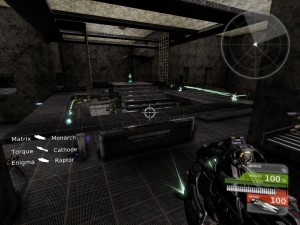by Annie | Sep 9, 2010 | Game Design
What can go wrong in a student game project? Tons. With so many moving parts, tight time restrictions, and limited experience, student projects can encounter countless obstacles, from technology challenges to critical miscommunication. So what’s the best thing to do when heading into a student project? Why, learn from others’ mistakes, of course. Here’s a good place to start: Student Project Disasters! How to Turn Knowledge From Failed Games Into a Boon For Your...

by Annie | Sep 8, 2010 | Game Design
Deathmatch. Sounds scary, eh? That’s because it is. But it’s also fun. Deathmatch levels are ones in which you go in to shoot and kill other players with the goal of achieving the most kills and/or being the last one standing. Of course, there are also navigation challenges and stealth skills to consider, adding to the fun of the level. My deathmatch level is aptly named “Cubic Clash.” As you might have guessed, the shape of the level is a cube. Three floors high with roughly nine square rooms on each level. Take a...

by Annie | Sep 7, 2010 | Game Design, Illustration Station
Who doesn’t love platform games? From Donkey Kong and Mario to Frogger and Doodle Jump, anyone can find a platformer to love. Over the past week, I’ve been refining an idea for a single screen platformer. Here’s the result: Combining the basic skills of color mixing with the challenges of spatial perception, Split Personalities is a single screen puzzle platform game in which players guide two characters through various colored platforms, turning the characters into the primary colors (red, yellow, or blue) necessary to form each level’s target secondary color (green, orange, or purple). The two characters occupy opposing sides of a split screen, moving simultaneously through different platforms. Not every platform is present on both sides of the screen, however, so as long as one character lands on a platform, the other character will occupy the same physical space on its side, even in the absence of the same platform. Each time a character lands on a platform, it absorbs that platform’s color. In order to complete each level, characters must arrive at the target door suited in the primary colors necessary to create the door’s secondary color. In this case, the target door is purple, so one character must be blue and the other red when arriving at the door. In addition, evil paint monsters will jump around, changing the colors of various platforms. Players will race against time, earning bonus points for faster level completion. No playable version yet; just a high level concept....

by Annie | Sep 3, 2010 | Game Design
Multiple choice tests have been a classroom assessment staple for decades. I remember many years of listening to teachers drone on about filling in the circle completely and making my mark heavy and dark. But what exactly do multiple choice assessments test? Process of elimination? Best guess strategies? Certainly not actual real world knowledge, right? This is exactly what the U.S. plans to overhaul within the next few years. Secretary Arne Duncan announced on Thursday that 44 states will share $330 million to work with university professors and testing experts to design a new series of assessments by the 2014-15 school year. Instead of testing students’ abilities to find trick answers or eliminate wrong ones, these new tests will require students to design experiments, manipulate parameters, and collect and analyze data. Sounds a little bit more like the real world, eh? Not only that, the new tests will be computerized, so teachers will receive instant feedback on student progress and misunderstandings and will be able to use that information to better tailor lesson plans. At least, that’s the hope. So where do games come into all of this? Essentially, if the new tests are well designed, they should resemble a series of games. If you think about it, each game you play is essentially a test. You build your skills through conquering obstacles, then use those skills to reach an objective. Similarly, students will “level up” in class, then use the assessments to manipulate virtual variables, testing their skills in order to achieve a goal. For young people today, games are fun, and school is not. Thus, the more we...
by Annie | Sep 1, 2010 | Game Design
Solid game design rests on a thorough grasp of psychology. If we can start to understand what motivates us in real life, we can create games that motivate us, and vice versa. Combine game motivation and real life motivation, and you’ll get some really motivated people. Take a...



